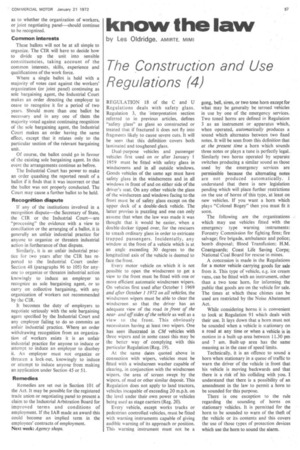know the law
Page 59

If you've noticed an error in this article please click here to report it so we can fix it.
by Les Oldridge, AMIRTE, MIMI
The construction and Use Regulations (4)
REGULATION 18 of the C and U Regulations deals with safety glass. Regulation 3, the 'interpretation section referred to in previous articles, defines "safety glass" as glass so constructed or treated that if fractured it does not fly into fragments likely to cause severe cuts. It will be seen that this definition covers both laminated and toughened glass.
Dual-purpose vehicles and passenger vehicles first used on or after January 1 1959 must be fitted with safety glass in windscreens and in all outside windows. Goods vehicles of the same age must have safety glass in the windscreens and in all windows in front of and on either side of the driver's seat. On any other vehicle the glass of the windscreen and windows facing to the front must be of safety glass except on the upper deck of a double-deck vehicle. The latter proviso is puzzling and one can only assume that when the law was made it was thought that it would be easier, when a double-decker tipped over, for the rescuers to smash ordinary glass in order to extricate trapped passengers. Incidentally, any window at the front of a vehicle which is at an angle exceeding 30 degrees to the longitudinal axis of the vehicle is deemed to face the front.
Every motor vehicle on .which it is not possible to open the windscreen to get a view to the front must be fitted with one or more efficient automatic windscreen wipers. On vehicles first used after October 1 1969 and after October 1 1972 on all vehicles, the windscreen wipers must be able to clear the windscreen so that the driver has an adequate view of the road in front of the nearand off sides of the vehicle as well as a view to the front. This obviously necessitates having at least two wipers. One has seen illustrated in CM vehicles with three wipers and in some caseg this may be the better way of complying with this particular Regulation (Reg. 19).
At the same dates quoted above in connection with wipers, vehicles must be fitted with a windscreen washer capable of clearing, in conjunction with the windscreen wipers, the area of screen swept by the wipers, of mud or other similar deposit. This Regulation does not apply to land tractors, vehicles incapable of exceeding 20 m.p.h. on the level under their own power or vehicles being used as stage carriers (Reg. 20).
Every vehicle, except works trucks or pedestrian controlled vehicles, must be fitted with warning instruments capable of giving audible warning of its approach or position. This warning instrument must not be a gong, bell, siren, or two tone horn except for what may be generally be termed vehicles in use by one of the emergency services. Two toned horns are defined in Regulation 3 as an instrument or apparatus which, when operated, automatically produces a sound which alternates between two fixed notes. It will be seen from this definition that at the present time a horn which sounds three notes or plays a tune is perfectly legal.. Similarly two horns operated by separate switches producing a similar sound as those used by the emergency services are permissible because the alternating notes are not produced automatically. I understand that there is new legislation pending which will place further restrictions on the use of horns of this type, at least on new vehicles. If you want a horn which plays "Colonel Bogey" then you must fit it soon.
The following are the organizations which may use vehicles fitted with the emergency type warning instruments: Forestry Commission for fighting fires; fire salvage; fire brigade, ambulance and police; bomb disposal; Blood Transfusion; H.M. Coastguards; Coast Life Saving Corps; National Coal Board for rescue in mines.
A concession is made in the Regulations for a motor vehicle carrying goods for sale from it. This type of vehicle, e.g. ice cream vans, can be fitted with an instrument, other than a two tone horn, for informing the public that goods are on the vehicle for sale. The times at which these chimes can be used are restricted by the Noise Abatement Act.
While considering horns it is convenient to look at Regulation 91 which deals with their use. It lays down that a horn must not be sounded when a vehicle is stationary on• a road at any time or when a vehicle is in motion in a built-up area between 11.30 pm and 7 am. Built-up area has the same meaning as in the case of speed limits.
Technically, it is an offence to sound a horn when stationary in a queue of traffic to warn the driver of the vehicle in front that his vehicle is moving backwards and that there is a risk of his colliding with you. I understand that there is a possibility of an amendment in the law to permit a horn to be sounded for this purpose.
There is one exception to the rule regarding the sounding of horns on stationary! vehicles. It is permitted for the horn to be sounded to warn of the theft of the vehicle or its. contents and this covers the use of those types of protection devices which use the horn to sound the alarm.










































































































